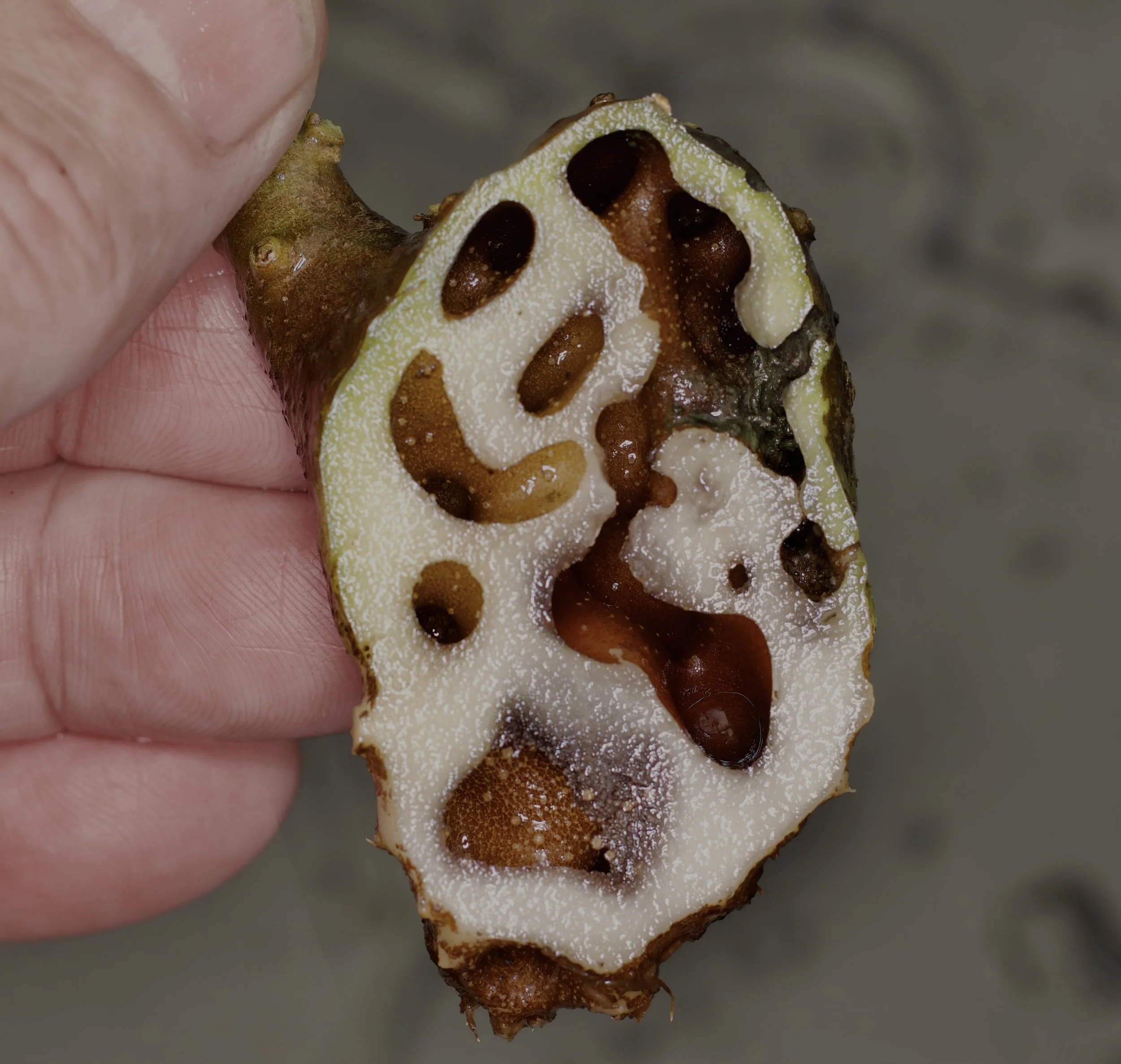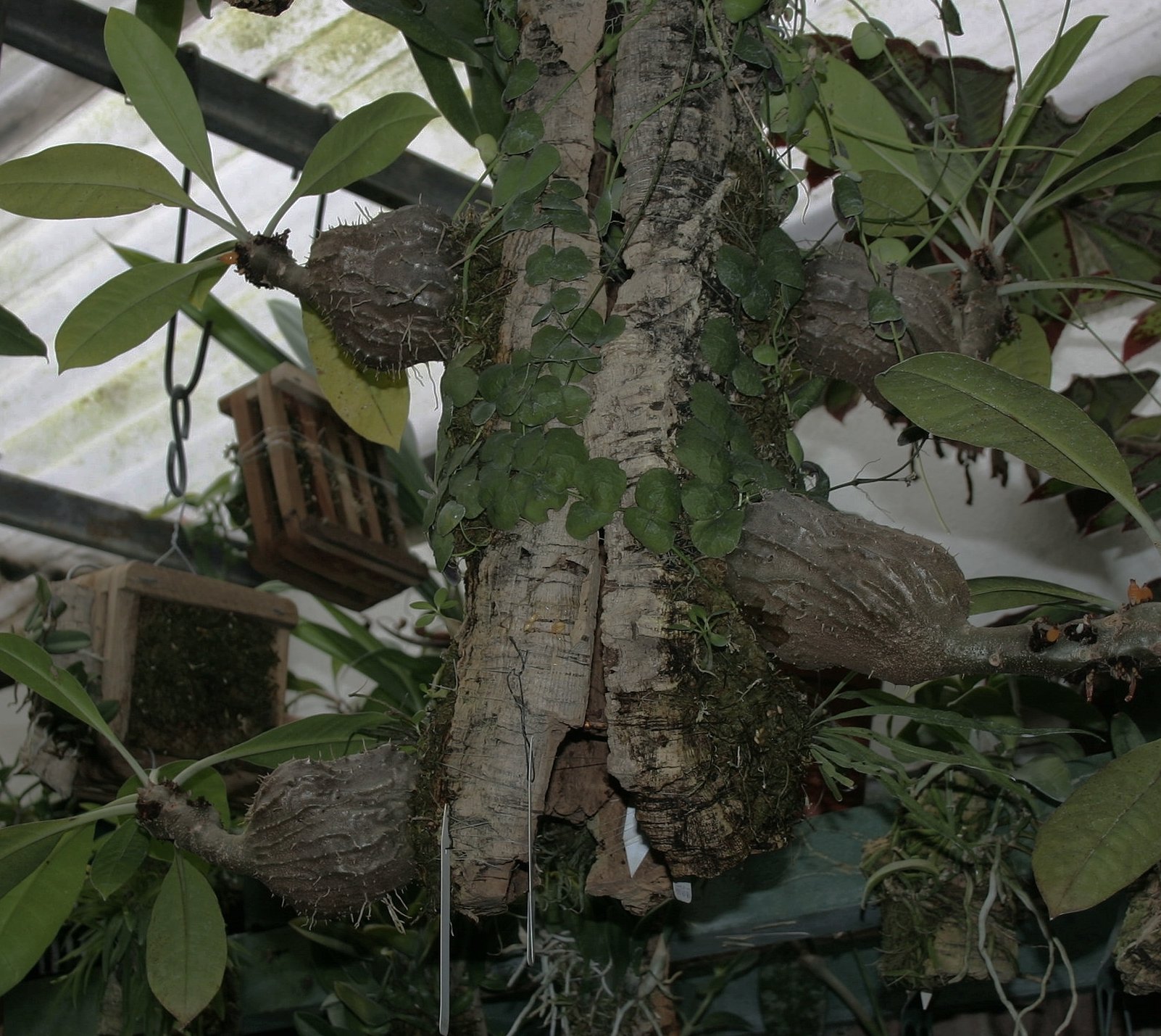Whiskers, warts, pimples, and scales
Rainforest Treegoblins in Captivity: The more than skin deep mysteries of Caudexed Ant Plants
by Jay Vannini
A large, seed-grown Myrmephytum sp. nov. “Yellow Fruit” on a greenhouse bench in the author’s collection. Large, well-grown Hydnophytines are comment-provoking educational display plants. Shown growing in a 12”/30 cm hydro basket. Image: ©Jay Vannini 2023.
Among the most interesting examples of animal-plant coevolution are to be found in the caudexed/tuberous Old World members of the Rubiaceae, subtribe Hydnophytinae (Huxley & Jebb, 1991a).
In lowland and intermediate elevation forested areas throughout their range, one or more species of Hydnophytinae are often anchor species for multispecies ant gardens that include other myrmecophytic (= ant plant) epiphytes such as orchids, ferns, and dogbanes such as hoyas and dischidias.
A cross-section of the caudex of a young Myrmecodia sp. Note how intricate the cavity design is even at this stage of development. Author’s plant. Image: ©Jay Vannini 2023.
Most members of the Hydnophytinae possess odd-looking, extremely succulent tubers/caudexes that usually are extensively channeled in their interiors from external pores to provide ready-made cavities or domatia for ants and other small fauna. In some species native to the uplands of Papua New Guinea, these tunnels extend from basal entry holes through to alveoli in the upper stems. A cross section of a young Myrmecodia species shows that these naturally occurring cavities and tunnels develop early on.
Molecular clock dating indicates that complex, obligate plant farming relationships between ants of the genus Philidris (subfamily Dolichoderinae) and various genera of myrmecophytic Rubiaceae likely date to between ca. two and six MYA with generalist relationships dating even earlier (Chomicki & Renner, 2016B; Chomicki et al., 2017). While these relationships are relatively ancient, they are nowhere near as old as the better-known symbiosis between Neotropical Attine ants (subfamily Myrmicinae) and their cultivated fungi (Nygaard et al., 2016).
As mentioned in an earlier article on this website and as unlikely as it may seem to many horticulturists, this remarkable group of mostly epiphytic plants still lack a universally accepted common name and are usually lumped under the imprecise generic term, “ant plants”. Since many far better-known floral families also have numerous genera or species that have ant associations for defense, pollination, nutrition, and dispersal, in my view this commonly used term is very much a less-than-satisfactory one.
In the absence of any other (for now, at least), I again propose the adoption of “Hydnophytine” and “Caudexed Ant Plant” as acceptable vernacular names for members of the Hydnophytinae. I make this recommendation even though several highly specialized taxa in the subtribe from high elevations are not known to be associated with ants or other insects but rather with other invertebrate phyla, or even frogs and lizards. Presumably occasional, opportunistic use of especially large tuber entry holes as diurnal refugia by bats and opposums in some epiphytic Hydnophytum spp. has also been documented (Jebb & Huxley, 2019).
Interest in these plants has increased greatly since the creation of the “Forum for Epiphytic Myrmecophytes” (singular myrmecophyton or myrmecophyte) by German botanist and plantsman Dr. Andreas Wistuba in 2014. This discussion group was instrumental in bringing together early collectors of these unusual plants from widely separate origins including Germany, France, the U.S., Japan, and Australia to share taxonomic findings, field experiences, cultural techniques, and images. While the forum’s influence and traffic has waned substantially over the past few years as social media “Show Me” groups have become more popular among newcomers, it remains the go-to site for curated information on the taxonomy and cultivation of all families of epiphytic ant plants. Hard-core Hydnophytine collectors should look to provide financial support for the maintenance of this invaluable resource by current administrator, Frank Omilian.
The sea cucumber-like caudex of a mature Squamellaria imberbis from Vanua Levu, Fiji. All species in this genus are highly desirable from a stem succulent collector’s perspective. Artificially-propagated seed-grown examples produced by U.S. and EU growers are slowly becoming more available. This is a first-generation domestically-produced plant from seed by specialist grower Frank Omilian. Author’s plant. Image: ©Jay Vannini 2023
The Hydnophytinae currently include five genera and between 102 and 117 accepted species depending on the authority (Huxley & Jebb, 1991c; Chomicki, 2021; Royal Botanical Gardens Kew - Plants of the World Online, 2023). These genera are–ordered by species diversity from highest to lowest–Hydnophytum, Myrmecodia, Anthorrhiza, Squamellaria and Myrmephytum. Within the genus Hydnophytum one unusual species (H. mamberamoense) with multiple growth axes and prominent winged interpetiolar stipules that resemble the clypeoli in Myrmecodia is likely to attract further critical review with an eye to erecting a new genus for it. The authors of a recent monograph on Hydnophytum admit that it was placed there more out of convenience than anything else (Jebb & Huxley, 2019).
Two members of Squamellaria (S. guppyana and S. kajewskii) from the Solomon Island chain have recently been moved from Hydnophytum based on DNA analysis (Chomicki & Renner, 2016a). While both species do share a clade that is linked to Squamellaria via molecular taxonomy, their caudex morphologies, flowers, and berries all indicate a very close relationship to Hydnophytum. Squamellaria vanuatuensis shares miniscule flowers and certain caudex characters with the two Solomon Island taxa. In my opinion, all three of these species warrant a thorough re-evaluation as to their proper taxonomic placement and may also deserve their own genus.
By 2014 and concurrent with the launch of the “Epiphytic Myrmecophytes” website, all five generally accepted Hydnophytine genera were represented in cultivation both outside of their range countries, together with those held by growers in Australia, Indonesia, and elsewhere in Malesia. The handful of somewhat ho-hum forms from three genera being grown (albeit rarely) in the EU and the US in the 1990s and 2000s had exploded to at least 70 species circulating more-or-less widely in cultivation by 2022 (de Vosjoli, 2004; F. Omilian, pers. comm.; Wistuba, 2023; pers. obs.). Three species, Hydnophytum moseleyanum (as H. “papuanum”), H. puffii (as H. “perangustum”), and Myrmecodia beccarii, were being grown from seed in large numbers for mass market in the EU and U.S. by at least one Dutch nursery during this period. Lesser numbers of two other species, an unidentified Myrmephytum sp. usually labeled as M. selebicum, and M. (tuberosa) dahlii, were also offered to the trade on a sporadic basis (P. Bak, pers. comm.; pers. obs.).
Several recent discoveries by commercial collectors show that the subtribe is likely far more species-diverse than current numbers would suggest. Of special note, diversity in Myrmecodia is likely significantly under-counted due to many obviously distinct populations of plants from across a vast range being lumped under “nicknames” (misrepresented as cultivar names within single quotes in the publication) under M. tuberosa in Huxley & Jebb (1993). Some of these forms included in their ochlospecies concept, including M. (tuberosa) dahlii, H. (tuberosa) papuana and H. (tuberosa) salomonensis, and two others, are now generally accepted as full species (e.g., Chomicki & Renner, 2016; pers. obs.). Based on mixed morphological characters, hybridization in nature is suspected among some self-incompatible species, especially those in the M. alata-erinacea complex in coastal southwestern Indonesian Papua where they sometimes occur in syntopy.
Petiole and clypeoli (winged structures at petiole bases) detail on an undescribed, ornamental species of Myrmecodia from Doorman’s Peak, Papua Province, Indonesia. Author’s collection. Image: ©Jay Vannini 2023.
Winter flowers on the formidably-armed rare eastern Papua New Guinea highlander, Anthorrhiza chrysacantha in the author’s collection. This is one of the larger epiphytic Hydnophytine species that will spontaneously set fruit in cultivation, almost certainly with the assistance of tiny insect pollinators. Image: ©Jay Vannini 2023.
A rare, albovariegated example of Hydnophytum cf. albertisii from Jayapura, Papua Province, Indonesia. The bold variegation shown here is stable and evident on almost all mature terminal growths. Author’s collection. Image: ©Jay Vannini 2023.
Caudex detail on Myrmecodia (tuberosa) aff. pulvinata from Sorong Regency, Papua Province, Indonesia. Note the short-stellate terminations on the root spines. This medium-sized, attractive species is justifiably popular among Hydnophytine collectors. Author’s collection. ©Image: Jay Vannini 2023.
A cascade of root spines on a caudex of the endangered Squamellaria major, endemic Taveuni Island, Fiji. The relict wild population of this species is estimated to be sub-100 mature individuals but – fortunately – it is now well-established in cultivation in the EU, Japan, and the U.S. Author’s collection. ©Image: Jay Vannini 2023.
A large example of a Philippine Hydnophytum sp. of indeterminate relationship in the author’s collection. Plants originating from regional markets usually lack locality and habitat information and are often vexing to identify with certainty. Image ©Jay Vannini 2023.
For open access articles on this website that deal with the cultivation of these remarkable plants, please see: https://www.exoticaesoterica.com/magazine/bonsai-ant-plants
…and: https://www.exoticaesoterica.com/magazine/the-big-five
Greenhouse propagated Hydnophytines for sale: From seedlings to specimen display plants – contact Jay Vannini at cyclanthaceae@gmail.com
To continue reading the rest of this and other Premium Content articles, please subscribe to Esotérica Exclusiva.
Access to deeper dives and behind the scenes looks into advanced tropical horticultural practices as well as observations on fieldwork, plant collection management, and Neotropical wildlife.
Follow us on:












